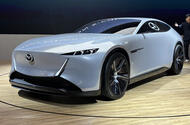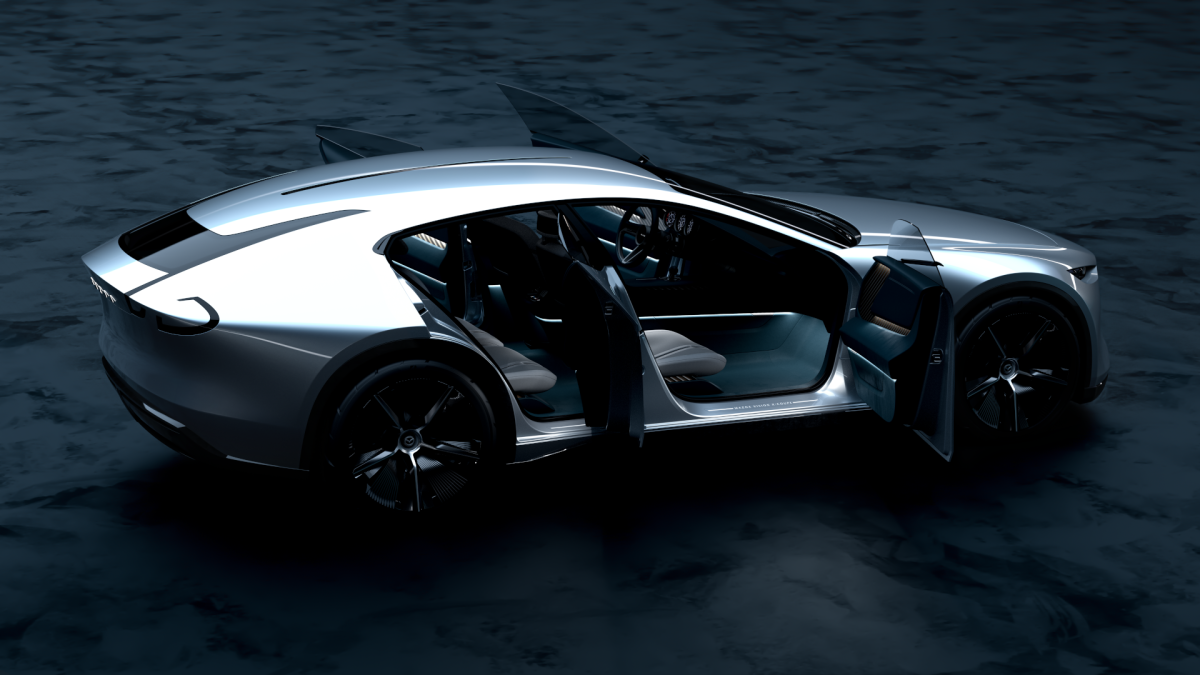Mazda’s New Rotary-EV Concept: A Sinister Step Backward in the Climate Crisis Debate, Disguised as Innovation and Progress
Mazda has made headlines with the unveiling of its latest concept car, the Vision X-Coupe, at the Tokyo Motor Show. This sleek four-door sports saloon boasts a powerful 503bhp rotary-electric powertrain and promises an impressive combined range of up to 500 miles. While the aesthetics and performance capabilities of the Vision X-Coupe may excite car enthusiasts, the underlying themes of its development raise significant questions regarding the future of sustainable mobility and the automotive industry’s responsibility in addressing climate change.
The Vision X-Coupe is a visual evolution of Mazda’s previous concepts, such as the Iconic SP and the RX-Vision, which showcased the brand’s Kodo design language. This design philosophy emphasizes sleek lines and dynamic forms, aiming to evoke a sense of motion even when the vehicle is stationary. The Vision X-Coupe’s design retains these characteristics, featuring a long, probing bonnet that hints at the power housed within. However, the appeal of its design should not overshadow the complexities of its powertrain and its implications for environmental sustainability.
At the heart of the Vision X-Coupe is a turbocharged two-motor engine, integrated into a plug-in hybrid system. Mazda claims that this system can enable the vehicle to travel up to 100 miles on electric power alone. This capability aligns with the growing consumer demand for electric vehicles, which offer the promise of reduced emissions and lower running costs. However, the hybrid nature of the vehicle raises questions about the reliance on fossil fuels and the effectiveness of hybrid technology in the broader context of climate change.
One of the more intriguing aspects of the Vision X-Coupe is its potential to utilize carbon-neutral fuel derived from microalgae. This innovative approach underscores Mazda’s commitment to exploring alternative fuels as a means of reducing the environmental impact of combustion engines. However, the effectiveness of such fuels remains a topic of debate among environmentalists and industry experts. While synthetic fuels may offer a temporary solution, they do not address the fundamental issues associated with fossil fuel dependency and the urgent need for a transition to fully electric vehicles.
In addition to its fuel innovations, the Vision X-Coupe is equipped with a ‘mobile carbon capture’ device, which Mazda claims will contribute to reducing atmospheric CO2 levels as the vehicle is driven. This technology presents an ambitious vision for the future of automotive manufacturing, where vehicles not only minimize emissions but actively contribute to carbon capture. However, the practicality and scalability of such technology remain uncertain, leading to skepticism about its real-world implications.
Mazda’s foray into the rotary-electric powertrain is not entirely new. The company has previously implemented this technology in its MX-30 crossover, suggesting a level of technical viability for the Vision X-Coupe. The rotary engine has long been a hallmark of Mazda’s engineering prowess, offering a lightweight and compact solution for power generation. However, the transition to electric and hybrid technologies has prompted a re-evaluation of this legacy, as consumers and regulators increasingly prioritize emissions reductions and sustainability.
The Vision X-Coupe’s dimensions place it in direct competition with other electric vehicles, such as the Polestar 5 and Lotus Emeya. These vehicles represent a growing segment of the automotive market focused on combining performance with sustainability. As more manufacturers enter this space, the pressure is on traditional automakers like Mazda to innovate continuously and adapt to changing consumer preferences.
Mazda’s commitment to synthetic fuels and carbon capture technology reflects a broader trend within the automotive industry. As electric vehicle adoption has faced challenges in various markets, some manufacturers have sought to explore alternative solutions that do not require a complete overhaul of existing infrastructure. This approach has garnered mixed reactions, with some praising the innovative spirit behind synthetic fuel development, while others criticize it as a distraction from the urgent need for full electrification.
The concept of evolving into a carbon-negative manufacturer, as Mazda has suggested, presents an ambitious goal. Capturing more CO2 than a company emits would position Mazda as a leader in corporate sustainability efforts. However, achieving this status requires not only technological advancements but also a fundamental shift in how the automotive industry operates. The complexities of supply chains, manufacturing processes, and consumer behaviors must all be addressed to truly make a meaningful impact on carbon emissions.
In the context of climate change, the automotive industry faces increasing scrutiny from consumers, regulators, and activists alike. The Vision X-Coupe, while a testament to Mazda’s engineering capabilities, serves as a reminder of the ongoing debate surrounding the role of traditional combustion engines in a rapidly changing world. The transition to electric vehicles has been hailed as a critical step in mitigating climate change, yet the persistence of hybrid and synthetic fuel technologies raises questions about the pace and direction of this transition.
As Mazda continues to explore innovative solutions to reduce its environmental footprint, the Vision X-Coupe stands as a symbol of both progress and controversy. The vehicle embodies the tension between the desire for performance and the imperative for sustainability. In a landscape where every choice carries significant weight, the automotive industry must grapple with the implications of its innovations, ensuring that they align with the broader goals of environmental stewardship and social responsibility.
The Vision X-Coupe may represent a step forward in Mazda’s design and engineering, but it also highlights the critical need for a unified approach to sustainability that transcends individual technologies and embraces a holistic vision for the future of mobility. The complexities of achieving true sustainability in the automotive sector demand a commitment to continuous innovation, rigorous accountability, and a willingness to confront the uncomfortable truths of our reliance on fossil fuels. As the debate around climate change intensifies, the Vision X-Coupe serves as both a beacon of hope and a reminder of the challenges that lie ahead in the quest for a sustainable automotive future.

Up to 500 miles of combined range for Mazda’s four-seat sports PHEV concept
Mazda has revealed a 503bhp sports saloon with a rotary-electric powertrain that promises up to 500 miles of combined range.
The Vision X-Coupe – star of the brand’s stage at the Tokyo motor show – is a sleek, rakish four-door that’s clearly evolved from the striking Iconic SP sports car concept Mazda revealed at the Tokyo show two years ago.
It is also, visually and conceptually, evolved from 2015’s RX-Vision concept, which set the tone for the Kodo design language the firm still deploys today, and previewed plans for a new generation of powertrain based around a rotary petrol engine.
Mazda has not given any firm specifications of the new concept, but says it uses a turbocharged two-motor engine as part of a plug-in hybrid system – which is said to be capable of travelling 100 miles with the engine off.
The concept is also said to be capable of running on a carbon-neutral fuel derived from micro algae, and is equipped with a ‘mobile carbon capture’ device, so “contributes to reducing atmospheric CO2 the more it is driven”.
Mazda uses a rotary-electric powertrain in the MX-30 crossover already, and has previously said it plans to put the 370bhp Iconic SP into production with the same technology – hinting at the technical viability of the Vision X-Coupé.
Unlike the mid-engined SP, though, this new four-door concept has its engine mounted at the front, under a long, probing bonnet that’s a signature of the Kodo language.
Overall, the new concept measures 5050mm long and 1480mm tall, making it the same sort of size as the similarly shaped Polestar 5 and Lotus Emeya.
The company has also been vocal about the potential for synthetic fuels to reduce the environmental impact of combustion engines, and has invested in their development while electric vehicle uptake has faltered in many of its key markets.
Ultimately, with carbon-capture and synthetic fuel capability in its future cars, Mazda has said it could even “evolve into a carbon-negative manufacturer” – meaning it captures more CO2 than it emits overall.


